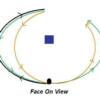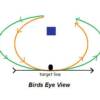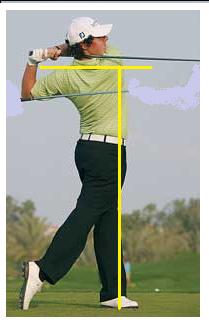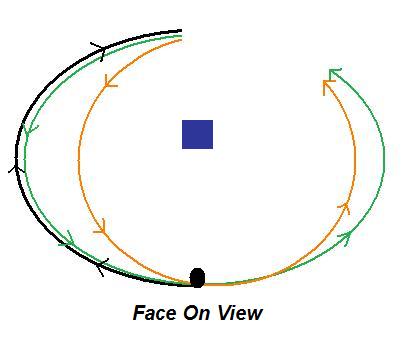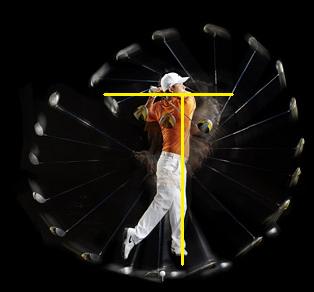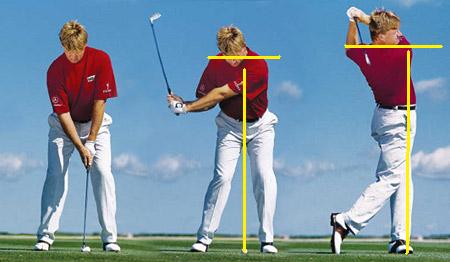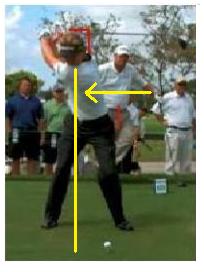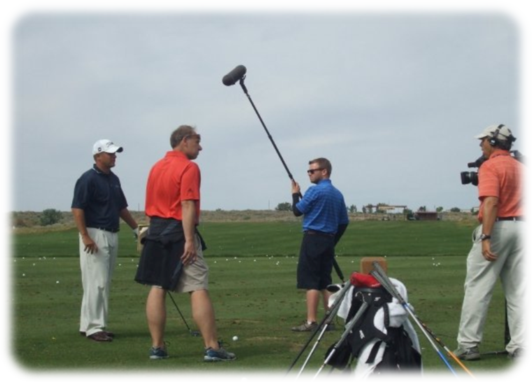What is the On Plane Swing?
In short... it is a golf swing that will deliver the clubhead to the ball in a more reliable, efficient and consistant impact position with less compensatory movements. You have heard many terms in the last few years... plane, circle, arc, impact position, cover, down the line, lag, down lag, late release, etc. I'm going to identify many of these terms and how they relate to the On Plane Swing. There are many different cosmetic golf swings that are successful on tour. If you inspect them very closely with a high speed camera then you will find out that ALL of them are very similar the last 18" the clubhead travels to the ball and makes impact. Positions such as... weight distribution at impact (more weight is on the forward foot than the rear foot), hand position in relation to golf ball (hands are leading the clubhead), hip position at impact (hips are open compared to hip position at the address position), posture (address and impact posture...they are not the same) .... all of these positions will be very similar when they are compared from tour player to tour player. How these players arrive at these postions is what makes their golf swings look cosmetically different. How these players arrive at impact usually determines which swings are more efficient and reliable, in my opinion. Again... how they arrive at impact or leave through impact really doesn't matter. It's the fact they they are there (correct impact position). Some players are there more often than other players. The question is... how do we get there (correct impact position) more often?
Ben Hogan stressed in his literatur... there are 2 swing arcs, the backswing arc and the forward swing arc. Hogan stressed that the shape of these arcs were quite different. The backswing arc was wide and the forward swing arc was narrow (up to impact). Also.. the forward swing arc pointed more right of target (right hand golfers) than the backswing arc (pointed down the line at target). For the most part that is the visual most professional golfers had up until maybe the mid 90's (I'm guilty of that as well) or up until Curtis Strange defended his 2nd U.S. Open. The current trends (One Plane, Stack & Tilt) have the forward swing arc very similar in shape to the Hogan 'forward swing' arc (circular) but differ on the directional position of the Hogan arc (Hogan's was pointed more right, current swing arc trends are directed down the line).
There are 3 aspects of the 'On Plane' swing for one to understand completely to improve how often and consistantly you arrive in a good impact position. In a nutshell: arcs, shoulders, and shift.
Arcs (or circle or plane): With the 'On Plane' swing... the 2 arcs are similar in shape and direction (on the same plane so to speak). Your clubhead travels a specific arc (or circle) on the backswing (a wide arc) and travels a VERY similar arc on the forward swing (a wide arc as well). If we could swing the clubhead on the exact same arcs... we would. This is different from the swings of 'yesteryear'. The first question you may ask is why would we change ANYTHING Ben Hogan thought or even challenge the current thinking? First... engineers developed a machine to hit perfect (well, theoretically, almost perfect) golf shots to test equipment many years ago. The Iron Byron machine is still used in this day and age to test equipment (or something similar to it). You really have to witness these machines hitting golf shots. They DO NOT miss shots, other than the occasional human error during set up or equipment error. Now, this machine has 2 arcs (backswing and forward swing arcs just like us). These 2 arcs are IDENTICAL on the Iron Byron machine. Having both arcs similar in shape and direction will have 1 VERY positive outcome: much fewer compensatory habits during the swing. In short, the less compensatory moves we have in the golf swing, the more efficiently and consistently we can arrive at a good impact position. Besides, why would we not try to emulate this machine? I will discuss this more in detail under the 'Back Swing Arc' and the 'Forward Swing Arc' section of this website.
Shoulders: At impact during the 'On Plane' swing, the head position is more 'on top' of the ball instead of leaning away/head behind the ball (iron swing). The shoulders are at the same angle of inclination as the shoulder position at address (or as close as possible). In order to achieve this.. you'll hear from me and many other instructors to 'cover the ball' at impact. Make NO mistake about this phrase (cover) ... it is EXTREMELY important to good golf shots. In fact, I implement many drills that teach this move. Level shoulders (angle at address and angle at impact are very similar) are EXTREMELY important for the 2 swing arcs (back and forward) to be similar in shape and direction. Your shoulder's position at the finish of the golf swing will be level as well (not tilted back, ala, the reverse c finish position). I will discuss this more in detail under the 'Shoulders' section of this website.
Dynamic Transfer of Weight (or weight shift). The action of the upper body (waist up to head..your torso) during the forward swing moves laterally towards the target (as it unwinds) until your head and right shoulder (right hand golfers) are completely vertical over top your forward foot (left foot for right hand golfer) at the finish of the golf swing. When done properly, you will be able to draw a straight line from the left foot, left hip, right shoulder, and your face at your finish position. I want you to examine the picture of Anthony Kim (to the left). Nobody does it better right now on tour. The upper body will physically move to the target during the forward swing's progression. It will feel as if your upper body is moving into the ball and through to the finish. This 'vertical' finish position will relieve a great deal of the back pain caused by the reverse c finish position that was taught many years ago (and unfortunately, still taught today). I will discuss this more in detail under the 'Dynamic Transfer of Weight' section of the website.
Great examples of these 3 attributes of the 'On Plane' swing are Luke Donald (dynamic transfer of weight), Rory McIlroy (dynamic transfer of weight), Nick Watney (shoulders, dynamic transfer of weight), Anthony Kim (dynamic transfer of weight, shoulders, arcs), Mark O'Meara (arcs), Ernie Els (shoulders, dynamic transfer of weight), Adam Scott (dynamic transfer of weight, shoulders), and Mike Weir (dynamic transfer of weight, arcs, shoulders...before his S&T experiment).
Black: Backswing Arc
Green: 'On Plane' Forward Swing Arc
Orange: 'Traditional' Forward Swing Arc
Notice the steeper angle of approach with 'Traditional' Arc
Level shoulders at impact and finish
Level shoulders and vertical finish ...
classic On Plane result!
Luke Donald shows how weight is transferred during back swing arc
